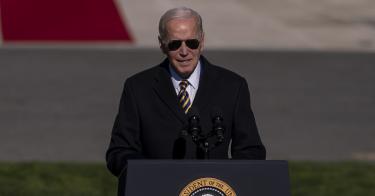The Biden administration’s decision to cancel the nuclear sea-launched cruise missile (SLCM-N) has been hotly debated since it was announced in April. The recently released Nuclear Posture Review only casts further doubt on the decision.
Initially proposed in 2018, the missile was one of two new capabilities intended to address the growing disparity in tactical nuclear weapons between the United States and its adversaries. The other new capability, a low-yield submarine-launched ballistic missile called the W76-2, has already been deployed.
Since these supplemental capabilities were proposed, the threats they were meant to deter have only worsened, making their need even more acute. Russia is openly threatening to use its nuclear weapons to coerce the West in its war of aggression in Ukraine, and China has embarked on a nuclear buildup that rivals the biggest expansions in history.
So, what drove the administration to cancel the SLCM-N program? Recent testimony of several top U.S. military leaders (including the Chairman and Vice-Chairman of the Joint Chiefs of Staff, along with the Commander of U.S. Strategic Command) in support of the SLCM-N calls into question whether the SLCM-N was cancelled for national security reasons.
>>> Russia, China and the Power of Nuclear Coercion
The administration’s newly released Nuclear Posture Review correctly recognizes the growing nuclear threat and rightly predicts that adjustments to strategy and force structure may be necessary to ensure deterrence remains effective. Yet, despite this realistic assessment, the review proceeds to dismiss the SLCM-N as “no longer required to meet our deterrence needs.”
You’d think that, given Russia’s explicit nuclear threats and China’s nuclear breakout, those deterrence requirements would be increasing, not decreasing. So, what gives?
Unfortunately, the review fails to connect the dots between the worsening threat environment and the administration’s decision. Its central argument for canceling the SLCM-N is a surprising one: the SLCM-N is no longer necessary because the W76-2 has been deployed. This implies that the W76-2, by itself, is sufficient to deter the advancing Russian and Chinese nuclear threats now and in the foreseeable future. Such logic is fatally flawed.
The two systems were explicitly proposed as a pair of capabilities that would complement each other. Military leaders made clear that the evolving nuclear threat required both systems; it never was an “either/or” deal. Earlier this year, Commander of U.S. Strategic Command, Admiral Charles Richard, warned Congress that “a deterrence and assurance gap exists.” This assessment was made despite the deployment of the W76-2.
Indeed, while both systems were intended to increase our ability to deter battlefield nuclear use by providing proportional responses, they satisfy this need in different ways. The W76-2 was developed as a stopgap measure intended to provide a limited capability to help deter the use of battlefield nukes in the near-term. The SLCM-N was under development as a longer-term response.
The W76-2 is deployed on strategic nuclear submarines. The SLCM-N, however, can be deployed on attack submarines or surface ships within both the European and Indo-Pacific theaters. This would increase the credibility of our nuclear response options to potential Russian or Chinese limited nuclear use and strengthen allied confidence in our extended deterrence commitments.
>>> China’s Nuclear Expansion and its Implications for U.S. Strategy and Security
Moreover, the W76-2 alone is unable to address the numeric growth in Chinese and Russian nuclear arsenals. Since the W76-2 is deployed on a strategic system, it is limited by the treaty caps in New START. Despite being a “new” capability, it cannot be used to increase the overall size of the U.S. nuclear arsenal. Effectively, its deployment only meant that a small number of already-deployed warheads were replaced with modified low-yield versions.
The argument that just a handful of low-yield warheads could pace the growth in Russian and Chinese nuclear arsenals is simply not credible. As a new program, the SLCM-N could be deployed in sufficient numbers to help meet increasing deterrence requirements. Failing to adjust the size of the U.S. arsenal will only allow the existing imbalance in non-strategic nuclear forces to continue to grow—which is profoundly destabilizing.
Fortunately, Congress seems to understand these points. It has already signaled its intent to overturn the Administration’s decision, as leaders in both chambers and parties have included funding for the SLCM-N in their defense policy bills for the upcoming fiscal year.
Hopefully, the Administration will realize the error of its logic and move to reverse its ill-considered decision regarding the SLCM-N.
This piece originally appeared in RealClear Defense




